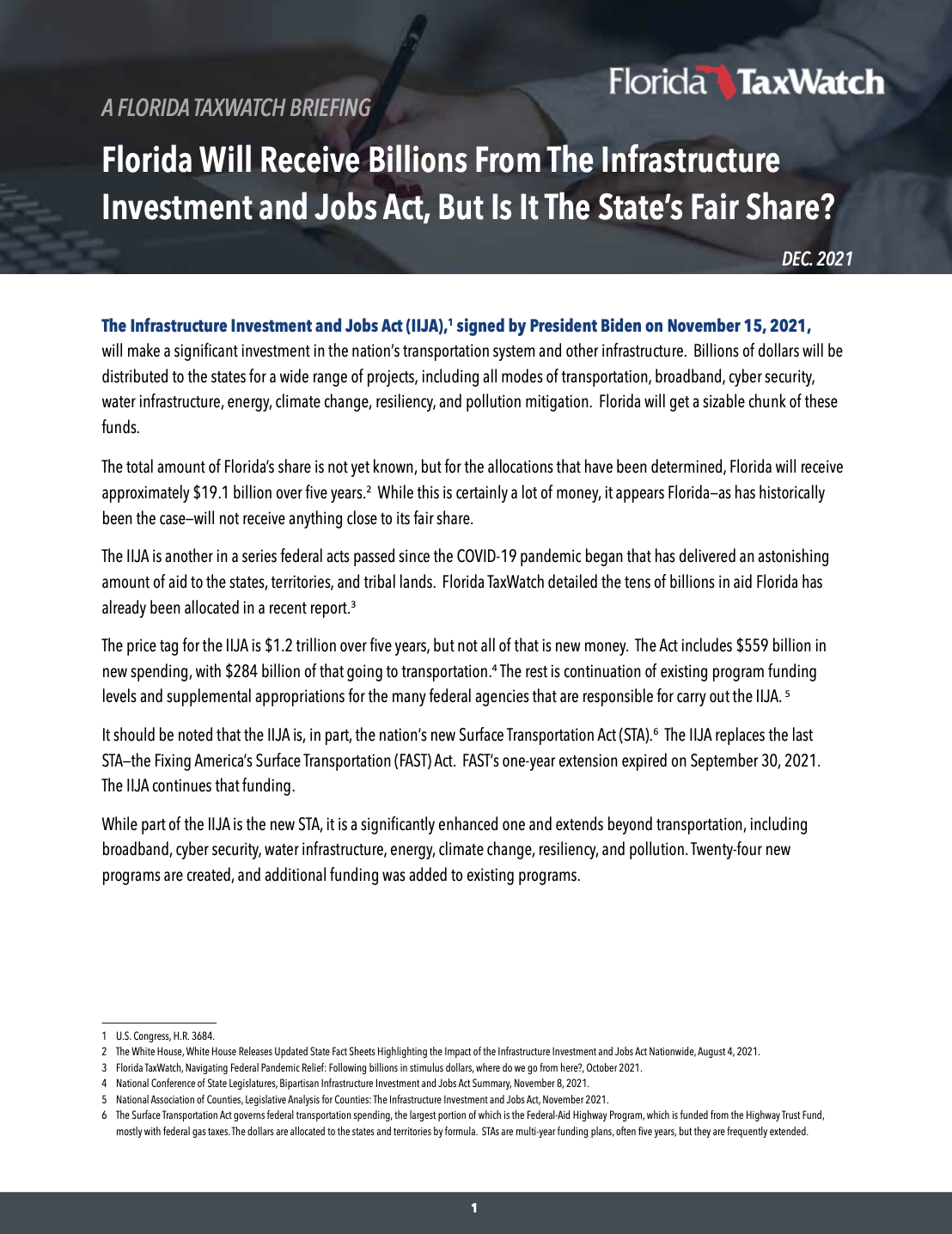Florida Will Receive Billions From The Infrastructure Investment and Jobs Act, But Is It The State’s Fair Share?

The Infrastructure Investment and Jobs Act (IIJA),1 signed by President Biden on November 15, 2021, will make a significant investment in the nation’s transportation system and other infrastructure. Billions of dollars will be distributed to the states for a wide range of projects, including all modes of transportation, broadband, cyber security, water infrastructure, energy, climate change, resiliency, and pollution mitigation. Florida will get a sizable chunk of these funds.
The total amount of Florida’s share is not yet known, but for the allocations that have been determined, Florida will receive approximately $19.1 billion over five years of the $425 billion got which allocations have estimated. While this is certainly a lot of money, it appears Florida—as has historically been the case—will not receive anything close to its fair share.
It should be noted that the IIJA is, in part, the nation’s new Surface Transportation Act (STA). The IIJA replaces the last STA—the Fixing America’s Surface Transportation (FAST) Act. FAST’s one-year extension expired on September 30, 2021. The IIJA continues that funding.
Estimates of the state allocations have been developed for $425.8 billion of the IIJA’s funds. The includes the Federal-Aid Highway Program (both old and new money) and some of the other new funding. The following is a summary of Florida’s $19.1 billion (of the $425 billion) share of these funds.
Transportation
Florida will receive an estimated $16.1 million in transportation funding from the IIJA, including $13.1 billion in traditional formula-driven federal aid, an approximately $3 billion increase
over the FAST ACT. This includes ongoing funding for roads, bridges, and transit. Florida will also receive an additional $2.6 billion for transit, $245 million for bridges, and $198 million for electric vehicle (EV) charging stations.
Florida can compete for an additional $31.0 billion in grants for bridges ($12.5 billion), transportation projects which will provide substantial economic benefits to communities ($16.0 billion), and EV charging stations ($2.5 billion).
Broadband
The bill provides $42.5 billion to expand broadband deployment to rural and other underserved areas. Florida will receive the base allocation of $100 million (same as all states). How the other $37.5 billion will be distributed was yet to be determined. The White House estimates this can provide access to the at least 707,000 Floridians who currently lack it. There is another $3.7 billion in competitive grants available.
In addition, an estimated 6.5 million Floridians (30 percent) will be eligible for the Affordability Connectivity Benefit (ACB), which will help low-income families afford internet access by providing a $30 per month subsidy for families at or below 200 percent of the federal poverty line.
Water Infrastructure
In an effort to provide clean drinking water to every American and eliminate the nation’s lead service lines and pipes, the IIJA provides $40.6 billion to the states. Florida is expected to receive $1.6 million.
Resiliency
Florida is allocated $29 million to protect against cyber-attacks and $26 million to protect against wildfires. Florida could also receive some of the $3.5 billion the IIJA provides for weatherization.
Airports
Florida is allocated $1.2 billion for airport improvements,10 with most of it distributed by formula to primary airports. General aviation and commercial service airports will also receive funds. An additional $5 billion is available to states through competitive grants, focusing on on-airport rail access and control towers.
When Florida does not get its fair share of federal assistance, our tax money goes to subsidize programs in other states. That is exactly what has been happening in Florida for many, many years. Florida TaxWatch has produced several reports showing that Florida receives far less than its fair share of federal aid relative to other states, consistently ranking near the bottom in terms of per capita grants and grants as a percentage of federal taxes paid.
If Florida’s share of funds from the new infrastructure bill was equal to its population share, our state would receive an additional $8.6 billion.